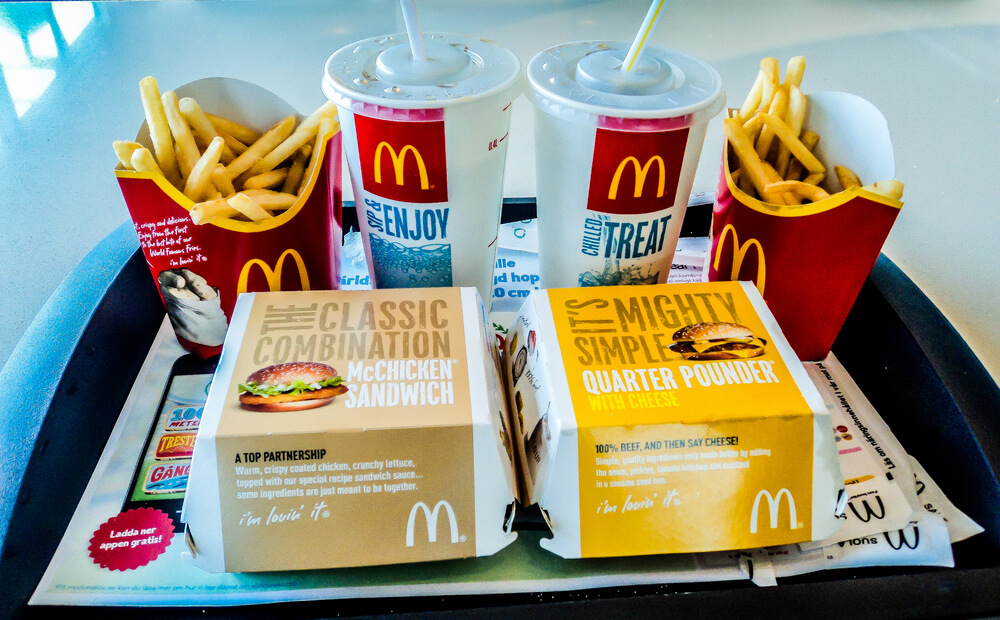You’ve seen the documentaries of guys eating nothing but McDonald’s food for 30 straight days, only to pack on the pounds. Of course, if you eat almost any kind of restaurant food straight for 30 days, you’ll probably pack on the pounds, today we will look into McDonald’s Nutrition.
But we’ve all driven past the burger joint late at night and head for the drive-through simply because nothing else is open.
But what exactly goes on with your body when you eat McDonald’s food?
We have all the answers on what you need to know and how you can safeguard your own diet against potential fast food pitfalls.
What You See In McDonald’s
You walk into the McDonald’s restaurant and peer up at the menu screen.
You already know what you’re going to get, but you look at it anyway. Underneath the menu items, you see the listen calories for the menu item and for the meal. At least you have a general idea as to how many calories you’ll intake with a Big Mac, medium fry and medium Coke.
However, it is what you don’t see listed on the menu that is what truly is the matter.
Going Deeper With McDonalds Nutrition
Naturally, the main menu over the worker’s head can’t give you all the health facts about what you’re about to put into your mouth.
However, the restaurant is required by law to provide you with a complete listing of nutrition facts.
There should be a chart up on the wall, along with literature for your mental consumption.
As you look through the menu items, you’ll see not just the calories, but the other dietary facts, which may alarm you. The Big Mac, for example, has 540 calories. If you were to pair it with a side salad and water, it wouldn’t be a terribly high-calorie intake for the meal.
However, 250 of the calories are from fat, along with 10 grams of saturated fat, which makes up 49% of your daily consumption. It’s also packed with sodium. 950mg of sodium, which is 40% of your daily intake, not to mention 9 grams of sugar and 46 total carbs (15% of your daily intake).
Now, there are some benefits, including the 25 grams of protein and 15% of your daily calcium, but if the sodium and saturated fat levels don’t frighten you, nothing will (McDonald’s 2017).
That is just an example of a burger with three slices of bread, served at a fast food restaurant.
Thankfully there are “healthier” alternatives, right?
After all, the Southwest Grilled Chicken Salad is listed at 350 calories on the menu, which is substantially better than some of the burgers with close to 1,000 calories. Again, you’ll see the 350 calories, 27 carbs (9% daily intake) and a solid 37 grams of protein, but it is in the hidden facts you need to look up where this healthy alternative isn’t all that healthy. It has 4.5 grams of saturated fat, 110mg of cholesterol (37% of your daily intake) and a whopping 1070mg of sodium (45% of your daily intake).
All of this salt, saturated fat and cholesterol is in a grilled chicken salad. A large order of the fries only has 350mg of sodium, and if you haven’t noticed, the fries can be pretty salty at times (not to mention the fries don’t have any cholesterol, trans fats or sugars).
Outside of the calorie jump, it is almost healthier to eat an order of fries than to purchase the salad (McDonald’s, 2017).
Mcdonalds Nutrition Is Worse In The USA?
If there is one thing you’ll always see, nearly regardless of where you travel, it is the golden arches of a McDonald’s.
But have you ever eaten the fast food in another country?
Did it taste a little different?
If it did, chances are it’s because it didn’t have as much sodium in it. According to research published by the Canadian Medical Association Journal, fast food in the United States is saltier than in any other country around the world. The difference often hit upwards of a 30% sodium difference (CNN, 2012).
So why would fast food in the United States be saltier than food in other countries?
A few different reasons. First, the United States does not have the same kind of food restrictions as other countries (such as the UK, New Zealand, and France). Another reason is the addition of sodium in food causes an individual to consume more of it. By increasing the amount of sodium in any given food, you are more likely to go back and purchase more during the same trip than with less sodium.
Lastly, the Canadian Medical Association Journal summarized local providers could play a part in the sodium increase as well, adding sodium at their end in order to preserve the food longer, which helps farmers receive large, important contracts from fast food chains, such as McDonald’s (CNN, 2012).
Why is Sodium So Bad?
Chances are, you already have a good idea as to why sodium is so bad for your body (especially if you have seen your doctor recently for that annual physical and they think your cholesterol is a bit high).
A diet consisting of too much sodium will increase your blood pressure in addition to forcing your kidneys to go into overdrive as the organs attempt to filter out all the salt.
The continual consumption of salt increases your chances of stroke, kidney disease, heart attacks, heart failure and all sorts of other cardiovascular diseases. According to researchers from the University of Harvard, 2.3 million deaths in the United States occur annually based completely off of too much sodium intake.
This is 10 percent of all heart, stroke and cardiovascular disease deaths caused by too much salt (Harvard, 2013).
So Why in the World is there So Much Salt in McDonald’s?
As you push your eyes back into your head after the eye-popping sodium numbers, you need to understand this is not a McDonald’s problem.
It is a processed food problem. As the vast majority of fast food chains rely on processed ingredients, nearly all have an excessive amount of sodium.
Sodium is used in processed foods for two reasons.
The first is to extend the life of the item, the second is to improve the taste. Having an extended shelf life is vital to the manufacturing of processed foods. Grocery stores are more likely to keep foods that last for six months instead of six weeks. The food needs to taste good in order to bring consumers back, yet processed foods often rely on inferior quality products. In order to make up for the quality of ingredients, sodium is used.
The practice of using salt to extend the life of food has been around for hundreds of years.
Salt, in many ways, acted as the first form of refrigeration. In order to extend the life of foods transported over long distances (especially on ships), the food would be salted.
For some foods, sodium helps bind ingredients and improve the color.
This is most commonly found in lunch meats (yes, that odd jelly-like container of turkey is processed turkey). Essentially, salt is the main ingredient for any processed food due to its life-extending ability (of the food, not you), its ability to make the food taste better and also look better (Fit Day, 2017).
Trouble Ditching the Weight? It Might Be the Sodium
Have you noticed you’re just not dropping those last few pounds?
No matter how much time you spend on the elliptical or how much weight you’re benching, if you’re having trouble dropping the last few pounds it likely is because of the sodium in your food.
After all, you’re watching your calories, you’re not eating high levels of fat or sugar, so what in the world is keeping you from dropping the weight?
That sodium is retaining all of the water weight and is preventing you from obtaining that formed, cut look you’re going after. So make sure to look at the amount of sodium in your food. Chances are, you’re eating some sort of processed food that has high levels of sodium (or it is in the “diet” soda’s you’re consuming). It is best to cut down on your sodium intake and increase the amount of water you’re drinking.
By doing that, you’ll begin to see those last few pounds start to melt away (SF Gate, 2017).
What Should You Eat At McDonald’s?
You’re driving down the highway of a long road trip, your stomach is growling and you are hungry, but the only stop open is McDonald’s.
You know you need to eat, but you don’t want to crush your simple diet plan (and you don’t really want to pick through the food options at a gas station). There are a few options available.
Here are a few you should consider.
If you want just a snack to hold you over, consider going with the Fruit ‘n’ Yogurt Parfait. This has only 150 calories and just 70mg of sodium. This is great for a little snack and basically just to have something in your belly, but it won’t sustain you most likely. So what to get that isn’t jam packed with calories,
So what to get that isn’t jam packed with calories, fat, and sodium?
There are a handful of salads to go with, but without the chicken.
Remember the Premium Southwest Chicken Salad?
Well, feel free to go back to it, just without the chicken. The processed chicken is where most of the sodium comes from. Without the chicken, it is only 140 calories with 150mg of sodium. The Premium Caesar Salad without chicken only has 90 calories and 180mg of sodium.
If you need a bit more protein to hold you over and you’re looking at something with meat in it, your options are a bit more limited. However, there are a few options to consider. The Chicken McNuggets four-piece is 190 calories with 360mg of sodium. This isn’t the best dietary option, but if you do need meat to sustain you for a bit, it is an option (these numbers do not include the dips).
Another option is the Fish McBites Snack Size that has 250 calories and 420mg of sodium. The last option is the small fries that is 230 calories and 160mg of sodium (although it has 11 grams of fat) (Dr. Gourmet, 2017).
One thing to always keep in mind is your beverage.
The beverages you consume while at Mcdonald’s has a major impact on the overall amount of sodium you intake. Diet sodas often have just as much, if not more sodium than the regular version as it is used to make up for the taste.
The sports drink options has a large amount of sodium as well. If you are going for healthy beverage options, you have to focus on just a few beverages. The first is water. You can never go wrong with water and it likely is the best option.
However, if you want a bit of flavor, consider the unsweetened tea or black coffee. Anything else though is going to drastically increase the amount of sodium you consume.
Conclusion
If you do need to make a stop at McDonald’s, you simply need to be mindful of what you’re doing and just double check the nutrition facts before eating anything at a fast food restaurant.
McDonald’s should never be looked at as a place to go for healthy meals. The restaurant chain is better now than ever before at providing healthier alternatives, so if a stop at the fast-food chain is necessary, you can go with a selection of options with lower calories and not the excessively high sodium levels. Just make sure to keep on guard with what you’re purchasing as overindulging in any fast food restaurant (not only McDonald’s) can harm both short and long-term health goals.
-Terry Asher
Terry Asher
Latest posts by Terry Asher (see all)
- Better Family – Product Review Liquid Daily 2 oz - Dec 16, 2024
- Post-Workout Recovery: The Key to Optimal Performance - Nov 25, 2024
- Pre-Workout Supplements – Everything You Need To Know - Nov 18, 2024















[…] post McDonald’s Nutrition – What Is Really Going In Your Body? appeared first on Gym […]
[…] at the time through an assembly-line procedure that the McDonald’s brothers invented. McDonald’s simplified the menus, offering only a few items so that customers wouldn’t be standing in line reading off all the […]
More information provided to me. Thank you for sharing this great article.
Thanks for sharing. I find a lot of interesting information here. A really good article, very thankful and hopefully you will write more articles like this one.